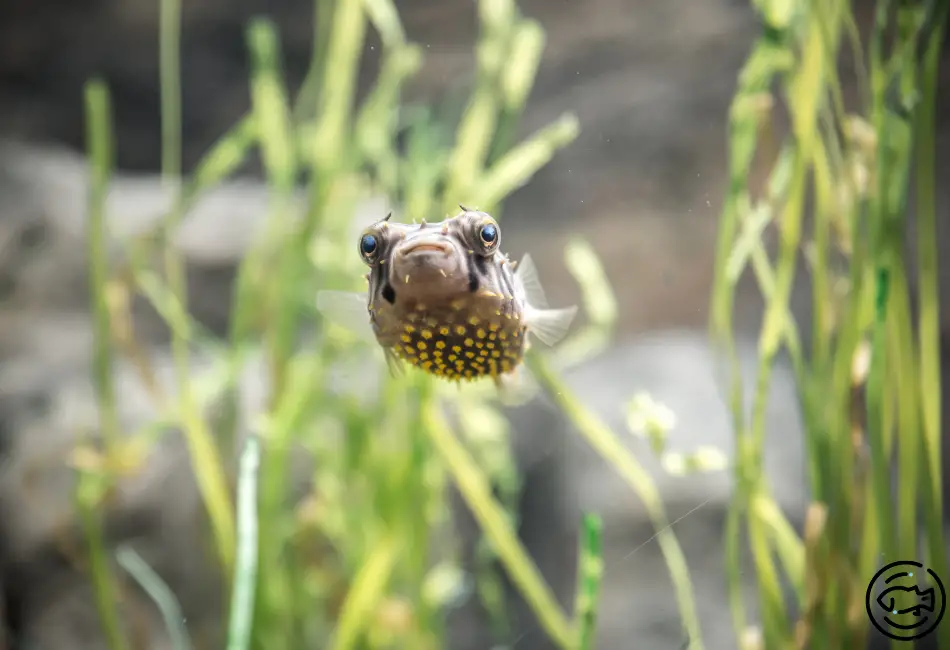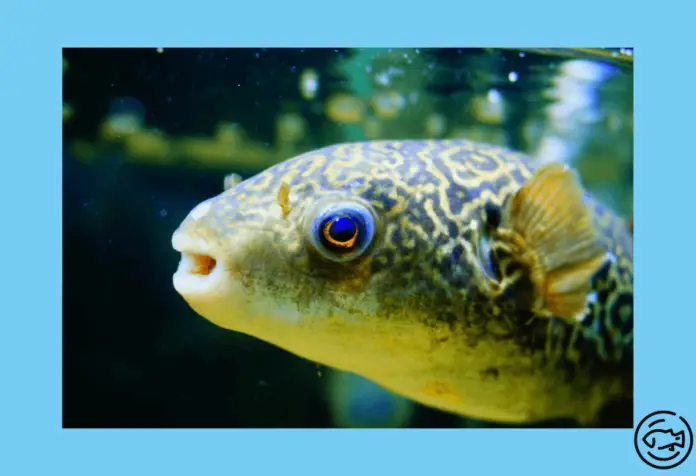Dive into the fascinating world of a Pea Puffer, also known as Pygmy Puffers, Mini Puffers, or Indian Mini Puffers (Carinotetraodon Travancoricus). These captivating creatures originate from Western India and require specific care to thrive in their aquatic environment.
In this comprehensive guide, we will explore essential aspects of Pea Puffer care, including their ideal tank conditions, temperature range, size, diet, and suitable tank mates.
Additionally, we will discuss their breeding habits, potential diseases, and overall lifespan to ensure you have all the knowledge needed to create a healthy habitat for your Pea Puffer.
| Attribute | Details |
|---|---|
| Common Name(s) | Pygmy Puffer, Mini Puffer, Indian Mini Puffer |
| Scientific Name | Carinotetraodon Travancoricus |
| Origin | Western India |
| Size | 1.5 inches |
| Temperature | 74-82°F (23-28°C) |
| Water pH | 7.0-8.0 |
| Food & Diet | Carnivorous diet |
| Disease | May be prone to ich |
| Minimum Tank Size | 10 gallons |
| Breeding | Breeding pairs lay eggs in dense plant cover |
| Tank Mates | Neon Tetras, Kuhli Loaches, and Adult Cherry Shrimp |
| Lifespan | 4 to 5 years |
Pea Puffer Care

Pea Puffers (Carinotetraodon travancoricus) are diminutive fish that reach a maximum size of 1.5 inches when fully grown. These tiny puffer fish hold the distinction of being the smallest puffers on the planet.
They display a yellow and green hue adorned with black markings on their bodies.
Some of these black markings are minuscule, while others are more prominent, and they also possess large eyes relative to their petite frame. They have a distinctive body shape, featuring a sizable head and body that tapers toward the tail, setting them apart from many other puffers.
Pea Puffer Facts
- Miniature Puffer species originating from Western India.
- Display territorial and aggressive traits, even with their small stature.
- Consume insects, larvae, and tiny invertebrates in their natural habitat.
- Vulnerable to fluctuations in water conditions.
- Require routine upkeep and careful observation.
Pea Puffer: Male Vs Female
Distinguishing between male and female Pea Puffers can be challenging, particularly for young fry. Yet, as they mature, it becomes achievable.
Male Pea Puffers possess deeper green areas and more vivid yellow abdomens. Additionally, males have a striking line running through their bodies and a bright blue hue in their eyes.
Female Pea Puffers exhibit a more rounded body shape, and their appearance is not as dynamic as the males’.
Tank Setup
Pea Puffers can thrive in an aquarium as compact as 10 gallons, making them suitable for nano tanks. Naturally, a more spacious tank would grant them additional room to explore, as in their natural habitat. For each extra puffer you introduce to the aquarium, allocate at least 5 gallons of space.
When it comes to water parameters, Puffers are highly sensitive to fluctuations. Thus, dependable testing equipment and regular water testing are essential. Puffers need temperatures between 72° & 84° F and a pH range of 7.0 to 8.0.
Promptly identify and address any water parameter issues.
In their natural environment, Pea Puffers inhabit densely vegetated areas. To make them feel secure, incorporate an abundance of plants into their tank setup. Adding caves, rocks, and driftwood can also be advantageous, providing ample hiding spots and areas to explore.
Optimal Substrate for Pea Puffer Tanks
Choose a substrate that promotes plant growth for your Pea Puffer tank, such as fine gravel or coarse sand. A layer of aquarium soil may also boost plant development.
Selecting the appropriate substrate is crucial for maintaining healthy plants and creating an ideal habitat for your Pea Puffer.
Aquarium Plants for Pea Puffer Tanks
Pea Puffers require numerous aquarium plants in their tank as it is vital to provide hiding spots in case they feel threatened. Plants like Java Moss are excellent due to their large leaves, which create ample shade.
Floating aquarium plants are also beneficial for the same reason.
Size & Lifespan
Pea Puffers may attain a maximum size of 1.5 inches when fully developed.
On average, they live for 4-5 years, and to ensure these fish enjoy the most extended life possible, providing appropriate care is essential.
Diet
Pea Puffers are meat-eating fish, and when in captivity, they should consume a diet of frozen food like bloodworms and brine shrimp. They can also enjoy live fish food such as snails and blackworms.
They primarily feed on insects, larvae, and other tiny invertebrates in their natural habitat. Although petite in size, Pea Puffers possess a considerable appetite.
To avoid overfeeding, contemplate giving smaller quantities more often. For instance, provide a half portion two times daily rather than an entire portion once a day.
Tank Mates
Pea Puffers, though small, are territorial and can exhibit aggression toward other aquatic creatures. As a result, choosing tank mates for them requires careful thought.
When housing multiple puffers together, make sure your aquarium is large enough to provide each with their individual territory.
Remember that Pea Puffers are fin-nippers, which may trouble slower-moving fish. You may notice torn or damaged fins if your Pea Puffers are nipping at other fish.
Do not keep puffers with larger fish that may harm or consume them.
Potential tank mates for Pea Puffers include Neon Tetras, Kuhli Loaches, certain Danios, and adult Cherry Shrimp. These companions should be able to avoid the Puffer’s advances and not cause stress or injury.
Add more plants as you introduce more fish, ensuring your Puffer has ample hiding spots and feels at ease.
Do Pea Puffers Puff Up?
Indeed, it is uncommon, but you might witness your pufferfish puffing up as a defense mechanism or merely for practice. They inflate by drawing in water to enlarge themselves and deter potential predators.
Left undisturbed, it will eventually return to its regular shape, but you must avoid intentionally stressing your pet to induce inflation.
Instead, browse online for photos and videos that showcase this phenomenon.
Additionally, if you need to relocate or transport your pea puffer, use a cup or tiny container (rather than a net) to ensure the fish stays submerged in water and avoids accidentally inhaling air.
How Many Pea Puffers Can A 10-Gallon Tank Hold?
Considering the territorial nature of pea puffers, many individuals successfully maintain just one puffer in a five-gallon aquarium alone.
If you desire to accommodate more than one, the general guideline is to assign five gallons of water for the 1st puffer and 3 gallons for each additional puffer.
In other words, you could hold three puffers in a 10-gallon tank and 6 to 7 puffers in a 20-gallon tank, but your success rate relies on the tank conditions.
A sparsely decorated tank with little cover will likely result in pufferfish confrontations. However, if you have a densely planted aquarium, you can accommodate three puffers in a 10-gallon space.
Naturally, a giant aquarium is preferable, and increased water volume allows for better waste dilution (since inferior water quality can damage your puffer’s health) and offers more space for the puffers to avoid one another.
Additionally, having a male-to-female ratio of one to two or three typically reduces aggression. Still, most puffers are sold as juveniles, making it difficult to determine their sex.
If you inadvertently purchase three young puffers and end up with one female and two males, you may require to rehome at least one male to minimize friction.
Temperament
Maintaining Pea Puffers in a mixed-species aquarium can be challenging. These tiny fish might be harassed or consumed by larger tankmates, as they aren’t swift swimmers and may struggle to escape danger.
They aren’t docile, so they might also target other fish, particularly slow-moving species with extended fins.
When introducing puffers to a community aquarium, choosing compatible tankmates & providing ample room for all occupants is essential.
Ensure live plants are abundant for shelter, allowing the fish to seek refuge when they feel intimidated.
Breeding
Under appropriate water conditions, Pea Puffers can reproduce in captivity. The male pursues the female until she is receptive, and they proceed to a concealed area beneath plants to mate.
The female typically deposits her eggs within dense foliage, like Java moss, where the male fertilizes them shortly after.
Once the eggs are laid, removing the parent fish is advisable. The eggs will hatch within a day or two, and the young will feed on infusoria and baby brine shrimp until they can consume more oversized food items.
Diseases
Pea Puffers don’t have a particular susceptibility to any specific illness. Nonetheless, as with many tropical fish, lower temperatures may compromise their immune systems, raising the likelihood of contracting Ich.
Moreover, They tend to be untidy when eating, and when consuming a snail, for instance, it can produce a significant amount of waste.
Consequently, cleaning the tank frequently is crucial to ensure optimal water quality, and substandard water conditions heighten the risk of infections and diseases.
Where To Find Pea Puffer Fish For Sale?
Pea Puffers are a favored choice for aquarium enthusiasts, making them accessible in numerous local pet shops.
Many online vendors also offer them, and it is advisable to buy tank-raised individuals, as feeding wild-caught ones can be pretty challenging.
Typically, they can be purchased for around $8-$10 each.
Conclusion
In conclusion, the Pea Puffer is an intriguing and charming addition to any aquarium, offering a unique personality and captivating appearance.
These fascinating fish can thrive in a home aquarium by carefully selecting compatible tank mates, providing a well-structured environment, and ensuring optimal water parameters.
With an understanding of their specific care requirements, diet, and where to purchase these delightful creatures, you can construct a relaxing habitat for your Pea Puffers and enjoy their lively presence for years.
Investing time and effort into their care and well-being will reward you with a fascinating and engaging underwater world.



